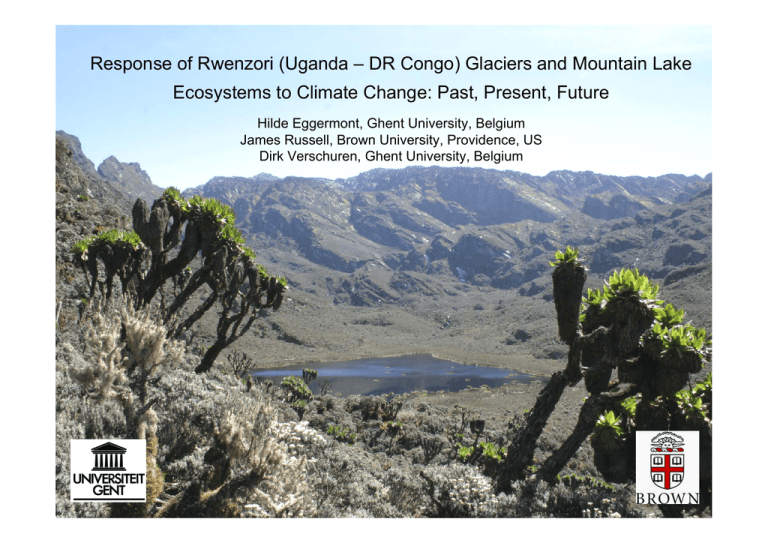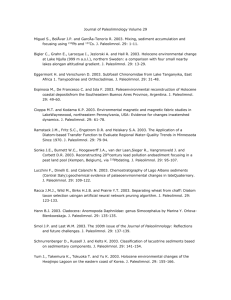Response of Rwenzori (Uganda – DR Congo) Glaciers and Mountain... Ecosystems to Climate Change: Past, Present, Future
advertisement

Response of Rwenzori (Uganda – DR Congo) Glaciers and Mountain Lake Ecosystems to Climate Change: Past, Present, Future Hilde Eggermont, Ghent University, Belgium James Russell, Brown University, Providence, US Dirk Verschuren, Ghent University, Belgium Outline • Study area ‘Mountains of the Moon’ • Context & Aims • Strategy & Preliminary results • Avenues for future research DR Congo UGANDA Observations of glacial termini confirm rapid glacial recession from 1906 to present From R. Taylor et al. (2007; ECRC Research report N° 113). Redrawn and adapted from Kaser and Osmaston (2002; ISBN 0 521 63333 8) Controlling factors of deglaciation are still the subject of debate... • Rising temperatures in recent decades (e.g. Bradley et al. 2006; Thompson et al. 2006; Taylor et al. 2006a-b) • Decrease in humidity at the end of the 19th century (ca. 1880) (e.g. Kaser et al. 2004; Mölg and Hardy 2004; Mölg et al. 2006) Lack of continuous quantitative records of alpine glacial extent in tropical East Africa prior to the 20th century has left the precise timing and drivers of recent glacial recession in the region equivocal Resilience of afroalpine glaciers and ecosystems against global warming remains largely unknown Overall Aim – To gain key insights into (1) Modern climatic, limnological and ecological conditions i.e. establishing (ecological, biological, physico-chemical) baseline data for the still relatively pristine Rwenzori lakes against which to compare future changes (2) Century-scale variability in rainfall and temperature and their impacts on alpine glaciation in central equatorial Africa during the mid-to late Holocene - development/calibration of climate proxies (e.g. Rainfall-independent paleothermometers) - long-term multi-proxy reconstructions in multiple lake sites (i.e. to separate regional climate signals from site-specific ecological processes) Strategy and preliminary results Fieldwork: July 2005 (dry season) July 2006 (dry season) May 2007 (wet season) Lakes Pools Eggermont et al. 2007. Hydrobiologia 592: 151-173 East Bukurungu, 3801 m, 17.3 m depth Lake Mahoma, 2990 m, 25.6 m depth Lake Bigata, 3998 m, 18.0 m depth East Bukurungu, 3801 m, 17.3 m depth Lake Batoda, 3890 m, 15.0 depth Lake Bujuku, 3891 m, 13.5 m depth Upper Kitandara, 4009 m, 14.5 m depth Lower Kitandara, 3989 m, 11 m depth Lac du Speke, 4235 m, 17 m depth Mutinda Pool, 3507 m Kamsongi’s Pool, Jesephat’s Pool, 4100 m Baguma’s Pool, 3993 m 4490 m, 0.8 m depth Salomon’s Pool, 4480 m Strategy and preliminary results 1. Determination of topography and vegetation 2. Determination of lake bathymetry 3. Recovery of continuous profiles of T, conductivity, pH and oxygen 4. Collection of water samples in lakes and rivers to determine general water chemistry Eggermont et al. 2007. Hydrobiologia 592: 151-173 Strategy and preliminary results 5. Sampling of the modern (living) biota in littoral, pelagic, benthic, epibenthic and epiphytic habitats (> 150 samples from various spots and seasons) Strategy and preliminary results 6. Determination of oxygen and hydrogen isotopic composition (d18O and dD) of river and lakes Russell et al. unpublished data Stable Isotope Compositions in western Uganda 50 40 Ruwenzori Lakes African Rainfall Station Lowland Lakes 30 20 GMWL Lowland Rivers Ruwenzori Rivers 2006 Rwenzori lakes 10 dD 0 2006 Rivers Linear (African Meteoric Water Line) -10 -20 -30 -40 -50 -8.0 -6.0 -4.0 -2.0 0.0 2.0 4.0 6.0 d18δ18O O => dD of aquatic lipids will provide direct insight into changes in the isotopic composition of precipitation in tropical East Africa, which varies as a function of rainfall amount. Strategy and preliminary results 7. Collection of intact surface-sediment samples for analysis of various climate-proxy indicators: geochemical biomarkers, fossil diatoms, algal pigments, pollen, and chironomids Strategy and preliminary results 8. In view of accurate T calibration and long-term T monitoring, we deployed 16 T loggers between ~1800-5000 m asl (recording 12 times/day since 2005/2006) Lakes Pools T-loggers From Eggermont et al. (2007; Hydrobiologia DOI 10.1007/s10750-007-0741-3) Strategy and preliminary results Chironomids as paleothermometers 0 10 Taxon number 20 30 40 50 60 0 MAT 5.5°C MAT 9.5°C 3800 m 3000 m 5 Eggermont et al. unpublished data 10 15 WA optimum (°C) 20 25 30 Strategy and preliminary results Chironomids as paleothermometers WA 25,0 r²jack = 0.96 22,5 RMSEP = 1.59°C Predicted MAT (°C) 20,0 17,5 15,0 12,5 10,0 7,5 5,0 2,5 0,0 0,0 2,5 5,0 7,5 10,0 12,5 15,0 17,5 20,0 22,5 25,0 Observed MAT (°C) Eggermont et al. unpublished data Strategy and preliminary results 9. Recovery of short sediment cores of recent sediments (150-700 yrs old) Strategy and preliminary results 9. Recovery of short sediment cores of recent sediments (150-200 yrs old) to - Assess archival quality of the lake sediments - Assess lake sensitivity to glacier retreat Russell et al. unpublished data - changes in the siliciclastic content of glacial lake sediments reflect fluctuations of glacial extent - signals of glacier dynamics can be isolate through comparative limnological studies Strategy and preliminary results 9. Recovery of short sediment cores of recent sediments (150-200 yrs old) to - Assess archival quality of the lake sediments - Assess lake sensitivity to glaciers retreat - Gather info on timing/triggers of deglaciation Russell et al. unpublished data Avenues for future research ... Long-term climatic, limnological and ecological monitoring ... Further development of climate proxies *Quantification of the relationship between changes in the stable isotopic composition of meteoric waters in the Rwenzori mountains and regional rainfall, T and atmospheric circulation using observational and climate modelling data *Optimalisation of the chironomid-based T models ... Multi-proxy study of long sediment cores (~mid- to late Holocene) from selected lake sites Conclusion - Rwenzori mountain lakes constitute a unique laboratory to do paleoclimate research - Our study will produce new records of Holocene climate variability to assess the coherency and spatial extent of climate changes within Africa and their relationships to global climate variability, solar forcing, and modes of tropical ocean circulation and temperature. - Our studies will provide baseline data to evaluate ongoing and future climate and environmental changes in this sensitive, alpine tropical area. Are recent changes unusual within the context of the mid- to late Holocene? - By providing climate records of temperature and rainfall that can be compared against independent records of tropical glaciation, our results will be important to ongoing studies evaluating the sensitivity of tropical glaciers to climate change Acknowledgements UNCST, UWA and Rwenzori Mountaineering Services for invaluable assistance in the field Fund for Scientific Research Flanders (Belgium), Leopold-III fund (Belgium), US National Geographic Society, Salomon Fund (Brown University) for sponsoring






